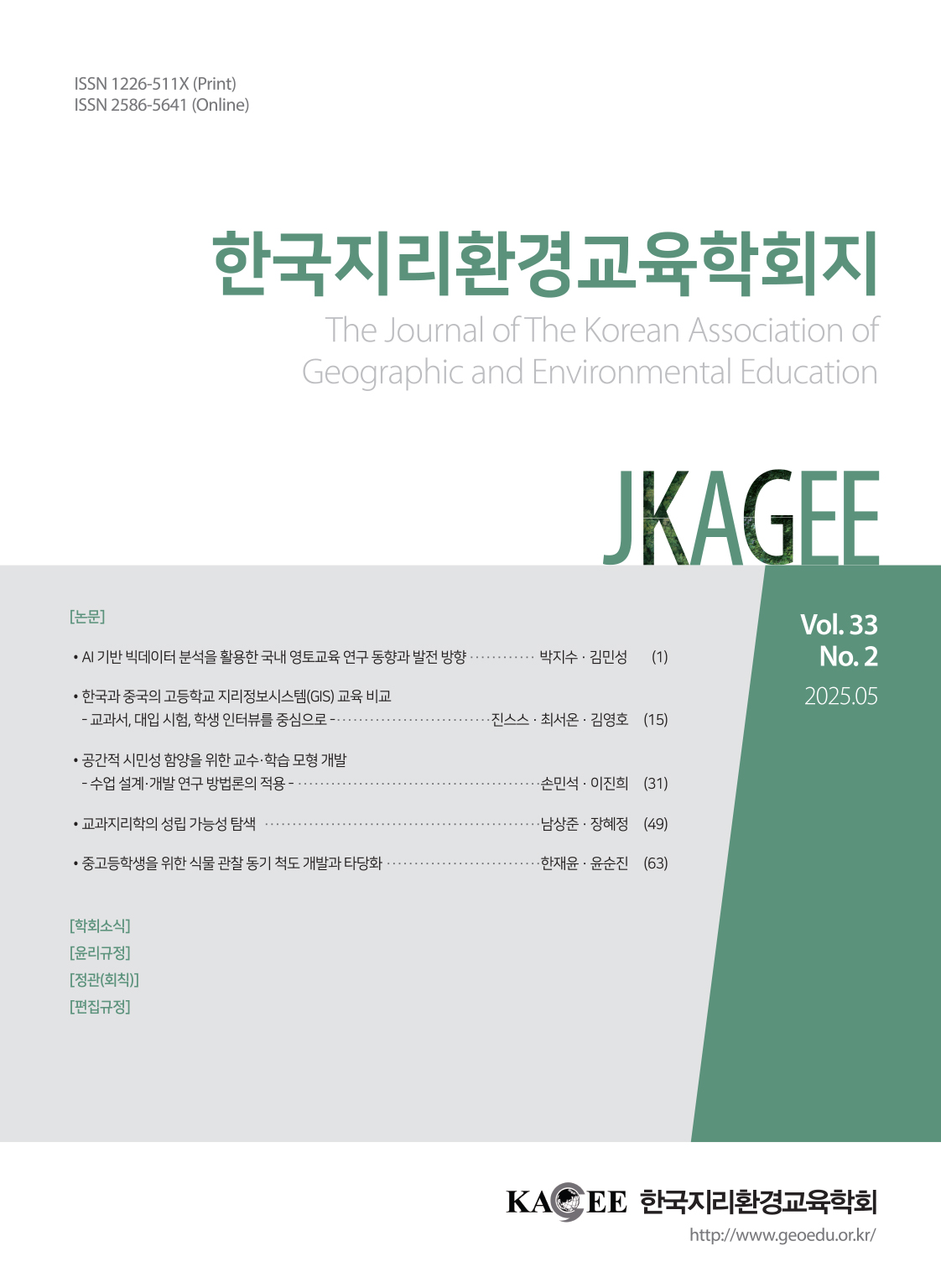Research Article
Abstract
References
Information
The purposes of this research are 1) to introduce the concepts of biophilia hypothesis and biophilic cities, 2) to study the awareness of university students about the concepts, and 3) to clarify factors to affect their awareness. To begin with, we conducted literature reviews as secondary research with regard to the concepts. Also, we conducted a questionnaire survey to ask sixteen factors to evaluate characteristics of the biophilic cities in order to learn their awareness. From literature reviews, we could learn that the biophilic cities could be defined as nature-ful cities based on the sustainability and resilience. In addition, from the survey, we could learn 1) the awareness of “the extent of educational programs teaching about nature” significantly differed between the one group that experienced nature-friendly voluntary activities and the other group that did not experience those activities, 2) grades of university students’ were positively related to the importance of two factors: “green design in cities” and “percent of residents who express care and concern for nature”, and 3) the awareness of planning elements was not significantly different among multiple groups, according to the city value that the university students regarded as crucial. As a result, we confirmed that our research model could be adopted to establish an urban planning or evaluate it as criteria and indices in terms of biophilic cities theme. Furthermore, we concluded that sustainability and resilience, as biophilic indicators, could be utilized for geographical education and environmental education in universities.
이 연구의 목적은 바이오필리아 가설(biophilia hypothesis)과 생명애 도시(biophilic cities)의 개념을 소개하고 생명애 도시에 대한 대학생들의 인식과 이에 영향을 미치는 요인을 알아보는 것이다. 이를 위하여 바이오필리아 가설과 생명애 도시에 대한 문헌 연구와 대학생들의 인식을 알아보기 위한 설문 조사를 실시하였다. 문헌 연구 결과, 생명애 도시란 지속가능성과 회복탄력성의 가치에 기반을 둔 자연으로 가득한 도시라고 정의할 수 있다. 생명애 도시를 구체적으로 특징짓고 평가할 수 있는 16개 주요 요소에 대한 대학생들의 인식 조사 결과는 다음과 같다. 첫째, 자연친화적 봉사 활동 경험의 유무에 따라서 ‘자연보호 프로그램 확대’에 대한 인식에 차이가 있다. 둘째, 연구 참여자의 학년이 올라감에 따라서(지식과 경험이 축적될수록) ‘도시의 녹색 디자인’과 ‘자연을 보호하는 시민의 비율’에 대해서 중요하게 생각하는 것으로 나타났다. 셋째, 대학생들이 중요하게 생각하는 도시의 가치에 따라서 생명애 도시 계획 요소에 대한 인식의 차이는 없는 것으로 나타났다. 다만, 중요하게 생각하는 계획 요소에 대한 가중치 평가 결과를 종합하면 ‘녹색 공간을 선호’하고 ‘자연보호를 실천’하거나 ‘자연에 대한 지식이 높은’ 시민의 비율, ‘생명 친화적 계획과 제도’를 생명애 도시를 나타내는 중요한 지표라고 인식하고 있음을 알 수 있었다. 이와 같은 결과를 종합하여, 이 연구에서 제시한 생명애 도시 인식 조사 연구 모델의 도시 계획 및 평가 지표로서의 활용 가능성을 확인 하였다. 더불어 대학의 지리·환경교육 분야에서 생명애 도시 지표를 활용한 지속가능성 및 회복탄력성의 가치를 다룰 수 있다는 교육적 시사점을 도출할 수 있었다.
- 곽혜란・채미연, 2018, “바이오필리아적 원예경험이 초등학생의 다감각증진에 미치는 효과”, 인간식물환경학회 2018년 추계학술대회 자료집, 143.
- 김묵한, 2017, “강력하고도 지속가능한 도시가 된다는 것”, 세계와도시, 18, 141-151.10.1111/jnc.1398428332228
- 박현찬, 2010, “서울 도시경관에 대한 인식 변화와 차이에 관한 연구”, 서울도시연구, 11(4), 33-49.
- 오영석・이곤수, 2005, “지속가능발전에 대한 주민인식조사: 경주시 6개 권역을 중심으로”, 한국정책과학학회보, 9(4), 239-257.
- 이민부・한주엽・장의선, 2002, “대도시 생활지역의 환경교육 사례 연구”, 한국지리환경교육학회지, 10(1), 65-75.
- 이지은・강민성・이승종, 2014. “도시위험인식이 행복감에 미치는 영향: 서울시 주민을 중심으로”, 지방정부연구, 18(2), 559-588.
- 임재택・하정연・이소영・신주연, 2012, “숲활동에서 형성되는 유아들의 관계 탐색”, 열린유아교육연구, 17(4), 119-145.
- 정은주・정봉현・나주몽, 2016, “도시의 지속가능성(Sustainability)과 리질리언스(Resilience)에 관한 연구”, 한국지역개발학회지, 28(4), 87-108.
- 조수진・장진아・이지영・오현경・전지혜・남상준, 2018, “초등 사회과에서 아동친화도시(CFC)의 논의 가능성 탐색: 지리・환경교육을 중심으로”, 한국지리환경교육학회지, 26(4), 17-31.10.17279/jkagee.2018.26.4.17
- 최돈민, 2015, “지속가능발전 관점에서 평생학습도시의 평가”, 교육종합연구, 13(3), 59-81.
- 최주영・박성준, 2019. “교육공간의 바이오필릭디자인 패턴 적용에 관한 연구”, 대한건축학회 2019년도 춘계학술발표대회논문집, 61-64.
- 한상미・이명훈, 2017, “지속가능하고 회복력 있는 도시개발 및 관리 평가지표: UN 지속가능한 발전목표(SDGs)의 목표 11을 중심으로”, 한국지역개발학회지, 29(3), 1-24.
- Beatley, T. and Peter, N., 2013, Biophilic cities are sustainable, resilient cities. Sustainability, 5, 3328-3345.10.3390/su5083328
- Beatley, T., 2009. Biophilic urbanism: Inviting nature back to our communities and into our lives, Environmental Law and Policy Rewiew, 34(1), 209-238.
- Beatley, T., 2011. Biophilic Cities: Integrating Nature Into Urban Design and Planning, Washington, DC: Island Press.10.5822/978-1-59726-986-5
- Peter, N., 2014. Biophilic urbanism: A case study on Singapore, Australian Planner, 51(1), 47-65.10.1080/07293682.2013.790832
- Ulrich, R., 1993, Biophilia, biophobia, and natural landscapes, in Kellert, S.R., and Wilson, E.O.(eds.), The Biophilia Hypothesis, Island Press, Washington, DC, 73-137.
- Wilson, E.O., 1986. Biophilia, Harvard University Press: Cambridge, MA, USA (안소연 역, 2010. 바이오필리아, 사이언스북스).
- Wilson, E., 1993, Biophilia and the Conservation Ethic, in Kellert, S.R., and Wilson, E.O.(eds.), The Biophilia Hypothesis, Island Press, Washington, DC, 31-41.
- Publisher :The Korean Association Of Geographic And Environmental Education
- Publisher(Ko) :한국지리환경교육학회
- Journal Title :The Journal of The Korean Association of Geographic and Environmental Education
- Journal Title(Ko) :한국지리환경교육학회지
- Volume : 28
- No :4
- Pages :73-90
- DOI :https://doi.org/10.17279/jkagee.2020.28.4.73



 The Journal of The Korean Association of Geographic and Environmental Education
The Journal of The Korean Association of Geographic and Environmental Education







